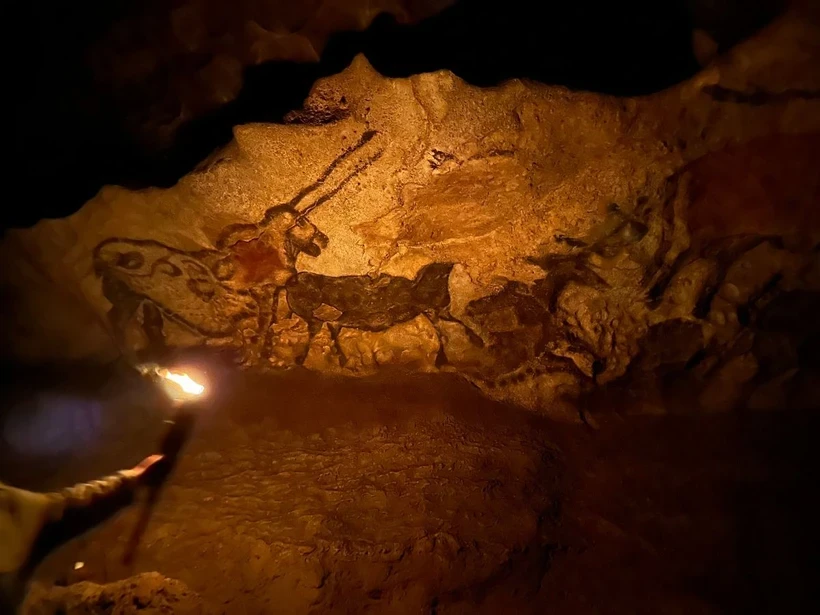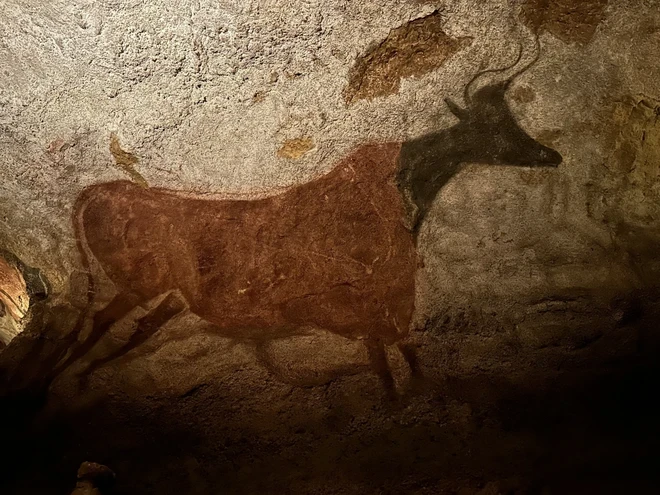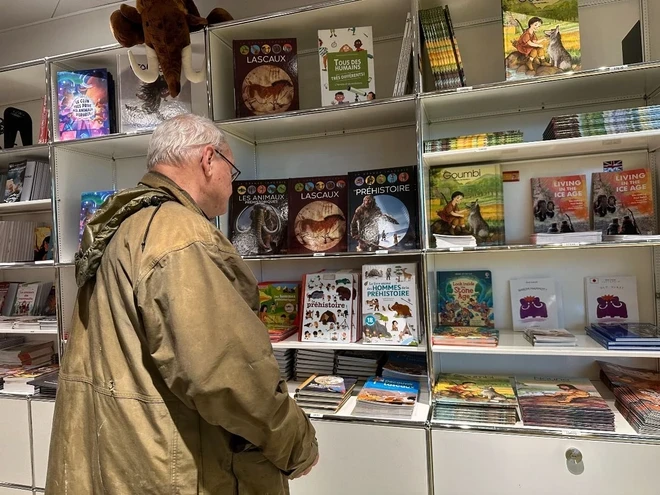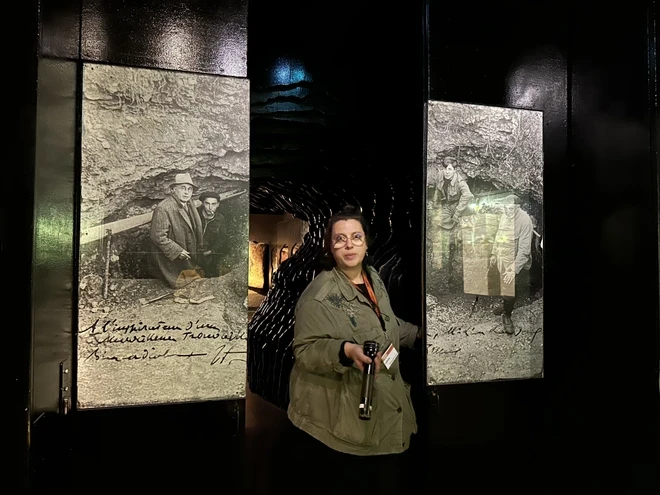With more than 2,000 drawings and carvings created 17,000 years ago, mainly images of bison, deer, horses..., Lascaux cave in France is a place that preserves messages from prehistoric people.

The Lascaux Caves, in the Dordogne department in southwestern France, are one of the world's most important treasure troves of prehistoric art.
This unique cultural heritage of humanity was recognized by UNESCO in 1979 and is one of the most attractive destinations for domestic and international tourists when visiting this region.
Located more than 600km south of Paris, Lascaux cave was discovered by accident in 1940 by four local boys.
The boys’ secret would not have been known to the world if they had kept it to themselves. But they couldn’t keep it to themselves when they showed it to their teacher, who was well aware of the significance of what lay hidden inside this seemingly ordinary cave system.
Immediately after being reported to the authorities, the Lascaux cave quickly became a groundbreaking archaeological discovery.
What scientists found here has completely changed people's understanding of the artistic and intellectual capacities of prehistoric people.
Lascaux Cave is a cave complex with a main cave, corridors and several smaller caves. Most of the images are painted on the cave walls with mineral pigments, while others are carved into the rock.
With more than 2,000 drawings and carvings created some 17,000 years ago, mainly depicting animals such as bison, horses, deer and abstract mythical creatures, these works of art not only demonstrate the ingenuity and creativity of prehistoric people, but also reflect the lives and customs of human ancestors in the Stone Age.
What is particularly impressive is the extraordinary artistic quality of the works, from the vivid colors to the exquisite perspective techniques, and the expression of the flexible movements of the animals depicted.
The main cave, called the Bull Room, is 20.1m wide and 4.9m high, and is also known as the Rotonde. It is the most magnificent painting room in the cave, attracting worldwide attention for its stunning murals depicting ancient French hunting scenes.
Archaeologists believe that this cave was used for a long time as a hunting center and a place for religious ceremonies, so they call it the "Sistine Chapel of prehistoric art."

Researchers also believe that the discovery of the Lascaux cave system has led people to profound understandings of the art, religion and life of prehistoric communities, thereby contributing to enriching knowledge about the history of human development.
With its valuable archaeological, cultural and historical values, this archaeological site was recognized by UNESCO in 1979, becoming a symbol of human cultural heritage.
Since its official opening to the public in 1943, the Lascaux Caves have quickly become a popular destination. In just 15 years since its opening, the Lascaux Caves have attracted over 1 million visitors.
However, the overload of tourists has caused changes in temperature and humidity, leading to the growth of bacteria and mold that threaten the ancient paintings, causing them to quickly deteriorate and even risk being destroyed.
This forced the French government to completely close the Lascaux cave in 1963 to protect this precious heritage.
Sharing with VNA reporters, Mr. Jean-Louis Mourtier, an employee working at this relic site, said that in 1998, he was lucky enough to visit the original cave when he was assigned to lead 4 scientists to survey this place for 35 minutes.
"Back then, permits were very limited, it was like a key to open the door to the cave. Getting that permit was a terrible stroke of luck. Since 2001, no one has been allowed to go in there," he added.
But that was not the end of the Lascaux story. Determined to present this treasure to the world while protecting the original, now known as Lascaux I, France built Lascaux II, which opened in 1983.
Version II accurately reproduces the two main rooms of the original, from the cave structure to the drawings, even the brick and charcoal colors used to draw the figures on the cave walls are the same materials that ancient people used.
Impressed with what they saw in Lascaux II cave, British tourists Jonathan and Francesca Muston confided: "This is a very meaningful visit because it helps us understand that 21,000 years ago we had a wonderful relationship with nature, a perfect symbiosis.
We are conscious of the food we eat. We are grateful to the animals we eat. Many of the cave paintings depict this message, as well as the respect that the ancients had for nature. That is why I wanted to come here today.
This artificial cave is just over 200m from the original cave. Every detail is recreated exactly like the original and it took the French 11 years to create this version II. It's amazing!"

According to Ms. Ludivine Texier, in charge of the Lascaux II relic site, to preserve the original heritage while still meeting the growing demand of tourists, the only way is to create an identical version and that is why Gascaux II was born.
"Soon after its opening in 1983, Gascaux II became the most visited and most returned site in the region.
Later, due to the overload of tourists, we built a larger version of Lascaux IV than version II with paintings and carvings on the cave walls, in addition to an archaeological site museum, integrated with 3D images, making it much more vivid.
Thanks to this, the number of tourists coming to Gascaux II has decreased, visitors can stay longer and we have time to clean this cave area of version II," Ms. Ludivine Texier explained, adding that version Lascaux III was built in a more flexible form so that it can be transported to serve international traveling exhibitions.
Inaugurated in 2016, Lascaux IV is a perfect replica of the original cave. Experts used the most modern technology to recreate every detail of the original cave, from the terrain to the rock textures, and especially the wall paintings with absolute accuracy.
Lascaux is not just a cultural destination but the heart of a rich tourist ecosystem in the Dordogne region. To realize this potential, the Lascaux IV complex, with an area of 8,500m2, offers visitors a multidimensional experience through guided tours of the recreated cave, a modern prehistoric art research center, interactive art workshops, a 3D cinema about the history of the cave and a digital exhibition space.
The replica allows visitors to experience the real cave without damaging the originals. The Lascaux complex welcomes over 250,000 visitors from around the world each year, making a significant contribution to the local and national economy.
Lascaux is not only a French heritage but a heritage of all humanity. It is a testament to the artistic creativity of human beings since the dawn of civilization, and an endless source of inspiration for future generations.
For the French, preserving and sustainably developing Lascaux is not only a responsibility to the past, but also a gift to the future./.

Source: https://baolangson.vn/hang-dong-lascaux-tai-phap-noi-luu-giu-thong-diep-cua-nguoi-tien-su-5028853.html


































































































Comment (0)